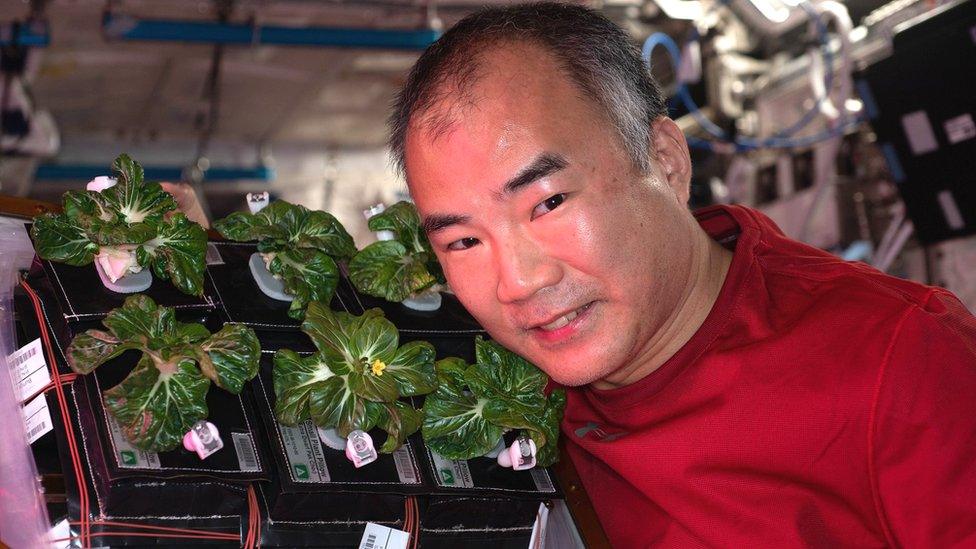Nasa project investigates - how do you water a plant in space?
- Published
- comments

Astronaut Soichi Noguchi posing with some dwarf pak choi plants growing aboard the International Space Station
How do you grow healthy plants in space? That's a question researchers at Nasa has been investigating.
Since 2014 astronauts on board the International Space Station (ISS) have had a special 'Veggie' garden, and have managed to grow everything from lettuce, to radish to flowers... with varying degrees of success.
This research is part of their bigger mission: To figure out how to feed astronauts on long journeys in space, like future missions to the Moon and Mars which could take weeks, months or even years.
Now, Nasa has launched the Glenn's Plant Water Management (PWM) project, to investigate the best way to water plants in space.
But watering plants in space is not as easy as you might think...
Why is it tricky to water plants in space?
Watering plants in zero-gravity is difficult for lots of different reasons. For starters astronauts can't just use a watering can like here on Earth - as the water would just float away!
Instead, astronauts use a syringe to inject water directly into 'plant pillows '- special bags that contain seed and fertilizer - and are put into the Vegetable Production System (AKA Veggie).
Water doesn't drain out of the bottom like it would here on Earth when a plant is watered, instead it can stay in the same place in the soil, causing the plant to become stressed.
Researchers have also discovered that plant roots grow differently in space, due to the lack gravity, making watering more difficult.
The first fully grown plant in space was an Arabidopsis - a plant related to cabbage and mustard. It was grown aboard the Soviet space station Salyut-7 in 1982.
Getting the right amount of air to a plant is also an important part of watering.
Astronauts discovered that if the air flow to the plants wasn't right, it could create high levels of humidity (water in the air) a bit like a tropical rainforest which could cause the plants to be under a lot of stress.
Guttation happens when pressure builds inside a plant forcing excess water out of the leaves. It happens when a plant is experiencing high humidity (levels of water in the air).
Epinasty is a condition that causes a plant's leaves to dramatically bend and curl downwards. This happens as a result of flooding in the roots.
Some plants even grew mould or bacteria from being too wet.
This balance between aeration (getting enough air) and hydration (getting enough water) is still one of Nasa's biggest concerns for growing plants in space.
What did researchers try in the Glenn's Plant Water Management (PWM)?
Astronaut Mike Hopkins works with the PWM hydroponics test on the ISS
As part of research to investigate the best way to water plants in space, the PWM team sent a number of artificial plants made from foam, felt and sponge to the ISS to test out two different watering methods.
The first method was using soil, and the second was using hydroponics, which involves growing plants directly in water.
The researchers chose to use artificial plants for the experiment as they would last longer than real ones, but would still act similarly to a real plant.
Take a look at the artificial plant being watered using hydroponics.
For the experiment the plants were 'watered' with a special fruit punch containing nutrients and sugars, instead of water, so researchers could more easily see the liquid being absorbed by the plants' roots.
Cameras on board the space station then fed the results back to researchers here on Earth, who could begin to work out how quickly the plants absorbed the fruit punch, helping them to work out which was the better method.
The PWM project finished its experiments on the ISS in early April, and researchers are now going through the results.
The team plans to run more experiments in the future to improve their space plant growing knowledge.
- Published16 May 2020
- Published20 November 2018
- Published20 January 2016
